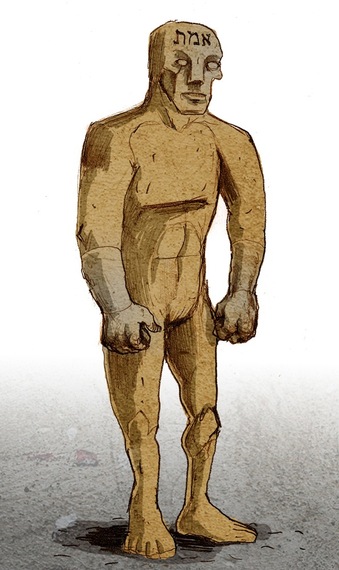R.L. Stine is big in our house right now, especially with the recent release of Goosebumps, the movie. Our last trip to the library, consequently, yielded Beware! (HarperCollins, 2002), a collection of stories--chosen and introduced by Stine--that scared and inspired him most as a child and a writer. Among them, Stine includes "The Terrifying Adventures of the Golem." Here's how he introduces the story:
The Golem is a character from Jewish folklore that has always fascinated me. I've always considered the Golem to be the first Frankenstein monster--and the first superhero. He was a giant figure made of clay and earth and water brought to life to battle the enemies of the Jewish people.
The first Golem story was told in medieval times... The most famous story--which I chose to retell--relates the adventures of the Golem of Prague, brought to life in the 1500s. Yes, the story is almost five hundred years old. But I think you will agree with me that it is as exciting as any superhero adventure story told today. (147)
It's his use of the phrase "first superhero" that I latch onto, as I read this story to my boys, and his choice to name the golem's adventures "terrifying" in the story's title. It's the dual capacities of protection and destruction that strikes me in the creature Stine goes on to write about, this creature so familiar to the Jewish imagination, a creature brought to life by the legendary Rabbi Loew "for one purpose--to help the Jews" (158). Over the course of the story, the golem rights numerous wrongs done to the Jews of Prague at the emperor's bidding, his heroism culminating in his exposing a Czech peddler as a baby-murderer, a murder committed with the intention of perpetuating the blood libel. The exposure of the peddler results in the emperor's "sending out a decree to his people... to leave the Jews alone." Order restored, Rabbi Loew declares, "The golem has served us well. Now it is time to put him to rest" (165). While the golem sleeps, Rabbi Loew erases the aleph from the word "emet" (truth) inscribed on his forehead, effecting "met" (death).
In his introduction, Stine alludes to the fact that the legend of the golem has a long and complicated history, with numerous iterations. In the popular imagination, the Prague golem has become something like a stand-in for all of them, folding together the various strands of the story and conflating them into a cautionary tale of unleashed power that is also the ultimate underdog narrative. In his telling, Stine emphasizes the protective nature of the golem over the destructive acts he commits. Though Stine's narrator demonstrates a brief wave of anxiety when the golem is brought to life--he wonders, "can such a giant truly be controlled?... has [the rabbi] made a horrifying mistake tonight?" (158)--the anxiety morphs into fascination and admiration for this creature that he has come to think of as a man, and he is overcome by a "wave of sadness" (166) when Rabbi Loew lays him to rest. In contrast to other iterations of the legend, where the golem wreaks havoc and has to be chased down by Rabbi Loew, in this version, the golem's end is peaceful. His power is controlled, checked and contained. No unleashed fury here; this golem behaves to the end like the dutiful servant he is conjured up to be. 
(https://commons.wikimedia.org/wiki/File:Golem_by_Philippe_Semeria.jpg)
With all due respect to Stine, master of all things terror, I have to confess that I'm wrestling with what makes this particular incarnation of the golem so terrifying. A superhero, to be sure, but... terrifying? Maybe I'm reading it wrong; after all, terrifying modifies "adventures" in Stine's title, not golem. Ah. Now it makes sense. Now it's the larger context surrounding the golem that's terrifying, his reason for being, the world that necessitates his creation.
Like Stine, I'm fascinated by this story, by its contours and implications. For me, it's the magical element of this story that compels, the echoes of Genesis in the creation of the golem from breath and dust, the speaking into being a creature that is both protector and destroyer. But mainly, I'm fascinated by the way the legend forces us to think about the easy slippage between truth and death, just a silent letter to distinguish between them. What are we to make of the erasure of that aleph? Is it a causal relation we're being asked to see, that the loss of truth leads to death? Or are we being prompted to think of death as the ultimate truth, the truth spoken through that silent letter, the truth we fail to speak though it is written indelibly upon us?
To me, the terror comes in contemplating this legend in the midst of so much gratuitous death, the truth staring us full in the face with each mass shooting, each terrorist attack, each despotic regime, each instance of police brutality, each sweeping insult cast against whole populations, each literal and metaphorical murder. It comes in the fatalism and resignation, the acceptance, with which we greet so much violence.
Maybe, in the end, what's most terrifying about Stine's version of the story is that he depicts a world in desperate need of a golem, a world I find all-too-reminiscent of the one we're living in. With so much golem-worthy history to learn from, it seems to me we should have evolved well beyond the need for a golem by now. Instead, each day's news brings more and more examples of savagery, physical, verbal and emotional. The cumulative effect numbs and hardens us. Like Stine's narrator, we look on, captivated as the carnage spills out before us, coming to accept it as a given, as inevitable, as truth. And maybe this is the most terrifying thing about Stine's version of the story: the ease with which truth slides into death, in sleepy oblivion, without putting up a fight.